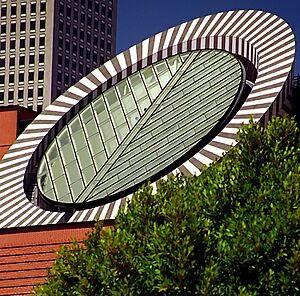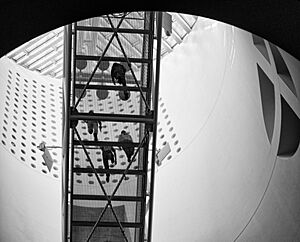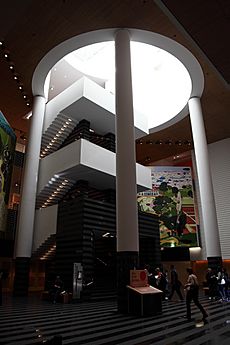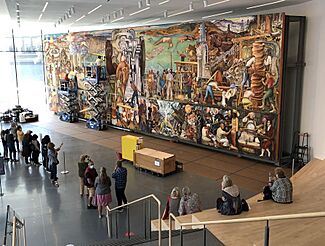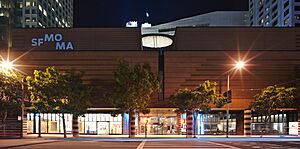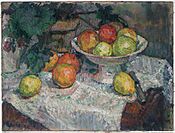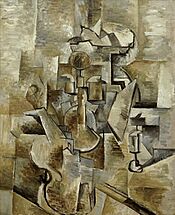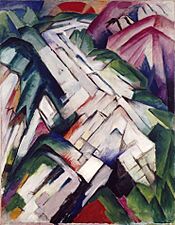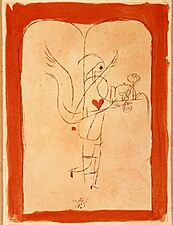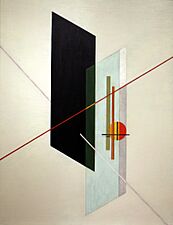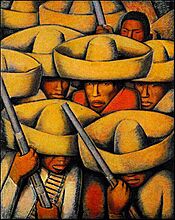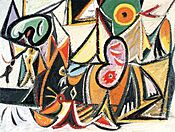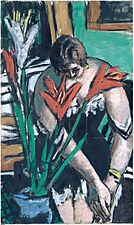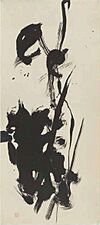San Francisco Museum of Modern Art facts for kids
 |
|

The 1995 Mario Botta-designed building with the 2016 Snøhetta-designed addition behind it
|
|
| Established | 1935 |
|---|---|
| Location | 151 Third Street San Francisco, California, United States |
| Collection size | 33,000 |
| Visitors | 1,113,984 (2017) |
| Architect | Mario Botta, 1995; Snøhetta, 2016 |
| Public transit access | |
The San Francisco Museum of Modern Art (SFMOMA) is a cool place to see modern and contemporary art in San Francisco, California. It was the first museum on the West Coast to focus only on art from the 20th century. SFMOMA has a huge collection of over 33,000 artworks. These include paintings, sculptures, photos, architecture, design, and media art.
The museum has 170,000 square feet (16,000 m2) of space to show its art. This makes it one of the biggest museums in the United States. It's also one of the largest in the world for modern and contemporary art. In 2024, the Washington Post said SFMOMA was the 14th best art museum in the U.S.
SFMOMA started in 1935 in the Veterans Building. In 1995, it moved to a new building designed by Mario Botta. This building is in the SoMa district. On May 14, 2016, the museum reopened after a big expansion. Snøhetta architects designed the new part. The museum now has more than double the gallery space. It also has almost six times more public space. This allows SFMOMA to show its growing collection and the amazing Doris and Donald Fisher Collection of contemporary art.
Contents
The Museum's Story
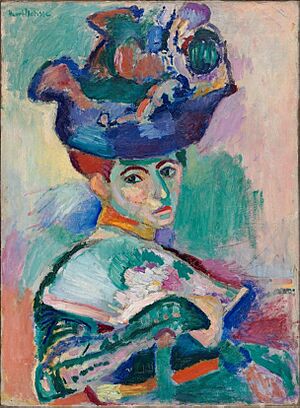
SFMOMA began in 1935 as the San Francisco Museum of Art. Grace L. McCann Morley was its first director. For 60 years, the museum was on the fourth floor of the Veterans Building. This building is on Van Ness Avenue.
A generous gift of 36 artworks started the museum's permanent collection. These came from Albert M. Bender. One famous piece was The Flower Carrier (1935) by Diego Rivera. Bender gave over 1,100 artworks to SFMOMA. He also created the museum's first fund to buy art.
In its second year, the museum showed works by Henri Matisse. In 1936, SFMOMA also started its photography collection. It was one of the first museums to see photography as a true art form. In 1940, the museum held its first architecture show.

The museum had to move in March 1945 for the United Nations Conference on International Organization. After the United Nations Charter was signed, the museum returned in July. Later that year, SFMOMA showed Jackson Pollock's first solo museum exhibition.
Grace Morley also started showing films at the museum in 1937. In 1946, filmmaker Frank Stauffacher created the Art in Cinema film series. This series ran for nine years. The museum also explored new media with a TV show in 1951. It was called Art in Your Life.
Morley left her director role in 1958 after 23 years. Henry T. Hopkins became director in 1974. Under his leadership, the museum became famous worldwide. In 1975, it added "Modern" to its name, becoming SFMOMA.
In the 1980s, SFMOMA created new jobs for art experts. These included curators for painting, sculpture, architecture, design, and media arts. The museum also started hosting many special art shows. These included works by Jeff Koons and Andy Warhol.
In 1992, Harry W. "Hunk" Anderson and Mary Margaret "Moo" Anderson gave many Pop art works to SFMOMA. These gifts included paintings by Jim Dine, Roy Lichtenstein, and Robert Indiana.
In January 1995, the museum opened its current building. It is at 151 Third Street. This location is next to Yerba Buena Gardens. Mario Botta, a Swiss architect, designed the new building. It cost US$60 million.
Under director David A. Ross (1998–2001), SFMOMA bought many important artworks. These included pieces by Ellsworth Kelly, René Magritte, and Piet Mondrian. It also acquired Marcel Duchamp’s famous Fountain. These purchases helped SFMOMA become one of the top modern art museums in America.
The 2003 exhibition Treasures Of Modern Art showed over 80 artworks. These were given by art supporter Phyllis Wattis. Her gifts included works by Robert Rauschenberg and Andy Warhol.
Neal Benezra became director in 2002. Under his leadership, more people visited the museum. Membership also grew. In 2005, the museum received a promise of almost 800 photographs. These came from the Prentice and Paul Sack collection. In 2008, the Frida Kahlo exhibition brought in over 400,000 visitors.
In 2009, SFMOMA received a special loan of art. This was the contemporary art collection of Doris and Donald Fisher. It includes about 1,100 works by artists like Alexander Calder and Andy Warhol. This collection will be at SFMOMA for 100 years.
In 2009, SFMOMA planned a big expansion. This was to fit more visitors, programs, and art. In 2010, the museum chose Snøhetta to design the new part. SFMOMA closed in May 2013 to start construction. It reopened three years later. During this time, SFMOMA held shows in other places.
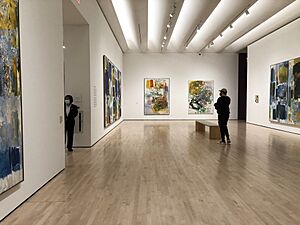
In 2011, the museum announced it bought 195 new artworks. These included paintings by Jackson Pollock and Francis Bacon. In 2012, 473 photographs were promised as gifts. These included works by Diane Arbus.
In 2022, Christopher Bedford became the new director. He took over from Neal Benezra.
Museum Architecture
The 1995 Mario Botta Building
In 1988, Mario Botta was chosen to design SFMOMA's new building. It was built on a 59,000-square-foot (5,500 m2) parking lot. This spot was on Third Street, near the Moscone Convention Center. Construction started in 1992, and the museum opened in 1995. This was the museum's 60th anniversary.
When it opened, SFMOMA was the largest new American art museum of the decade. It had 50,000 square feet (4,600 m2) of exhibition space. This made it the second-largest building in the U.S. just for modern art.
The Botta building has galleries around a central, skylighted area. The outside has brick walls with stripes. A tall, striped tower in the middle became the museum's symbol. It has a huge skylight at the top. Inside, the design uses black granite and wood.
Rooftop Sculpture Garden and Pavilion
In 2009, SFMOMA opened a 14,400 sq ft (1,340 m2) rooftop sculpture garden. It is above the museum's parking garage. A bridge connects it to the fifth-floor galleries. Jensen Architects designed the garden. It has two outdoor areas for plants and sculptures. There is also a glass building for dining. From the garden, you can see great views of the city.
The 2016 Snøhetta Expansion
In 2009, SFMOMA decided to expand because more people were visiting. Also, its art collection was growing. In 2010, the Norwegian architecture firm Snøhetta was chosen to design the expansion.
On May 14, 2016, the museum reopened after three years of construction. The new part added about 235,000-square-foot (21,800 m2) of space. It connected to the old building. The expanded museum has seven floors for art and public events. It also has three floors for museum operations.
The new building offers about 142,000 square feet (13,200 m2) of indoor and outdoor gallery space. It also has almost 15,000 square feet (1,400 m2) of free public space. This more than doubled the museum's ability to show art. It also gave visitors almost six times more public space. The tall "silo" and its Oculus Bridge stayed.
The expanded building has a large vertical garden on the third floor. It is said to be San Francisco's biggest public living wall of native plants. The ground floor has the free Roberts Family Gallery. Its 25-foot (7.6 m) glass walls let people see art from the street. There is also a special "white box" space on the fourth floor for art. It has advanced lighting and sound. The seventh floor has modern art studios. It also has a long balcony with views of the city skyline.
The outside of the new building uses lightweight panels. These are made of a special plastic material. This was the largest use of this technology in U.S. architecture at the time. The building also earned LEED Gold certification. This means it is very energy efficient.
Museum Leadership
Robert J. Fisher is the chairperson of the SFMOMA Board of Trustees. Diana Nelson is the president. Artists like Tucker Nichols and Carrie Mae Weems also serve on the board.
Christopher Bedford is the current Director of SFMOMA. He was appointed in 2022. Past directors include Grace Morley (1935–1958) and Neal Benezra (2002–2022).
Art Collections and Programs
Many famous artists had their first museum shows at SFMOMA. These include Jackson Pollock, Clyfford Still, and Arshile Gorky.
The museum's collection has important works by many artists. Some of these are Ansel Adams, Frida Kahlo, Henri Matisse, Diego Rivera, and Andy Warhol.
Experts called curators manage the collection. There are curators for painting, sculpture, photography, architecture, design, and media arts.
SFMOMA's website lets you explore the museum's art collection. The SFMOMA Audio App gives information about specific artworks.
The Research Library started in 1935. It has many resources about modern and contemporary art. These include books, magazines, and artist files.
The Koret Education Center on the second floor helps teachers. It also hosts events and talks. Larger events happen in the theater on the first floor.
SFMOMA has published many books and catalogs. These explain exhibitions and the museum's collection. Recent books include Joan Mitchell (2021).
Selected Highlights
- Frieda and Diego Rivera by Frida Kahlo, 1931
- The Flower Carrier by Diego Rivera, 1935
- Boston Common by David Park, 1935
- PH-371 (1947-S) by Clyfford Still, 1947
- Guardians of the Secret by Jackson Pollock, 1943
- Collection by Robert Rauschenberg, 1954/1955
- Incision by Jay Defeo, 1958–60
- St. Valentine's Day Massacre/Homage to Errol Flynn by Bruce Conner, 1960
- Polar Stampede by Lee Krasner, 1960
- No. 14 by Mark Rothko, 1960
- Cityscape #1 by Richard Diebenkorn, 1963
- Intermission by Edward Hopper, 1963
- Noel in the Kitchen by Joan Brown, ca. 1964
- Self-Portrait by Andy Warhol, 1967
- Untitled, from the portfolio Troubled Waters by William Eggleston, 1970–73
- My Mother Posing for Me, from the series Pictures from Home by Larry Sultan, 1984
- Sunset Streets by Wayne Thiebaud, 1985
- Michael Jackson and Bubbles by Jeff Koons, 1988
- Bracket by Joan Mitchell, 1989
- Hand Tools by Jerome Caja, ca. 1990
- Narkissos by Jess, 1976–1991
- Spider by Louise Bourgeois, 1995
- Delusions by Richard Mayhew, 2000
- Honey-Pop chair by Tokujin Yoshioka, 2001
- Drawing Restraint 14 by Matthew Barney, 2006
Gallery
This gallery shows images of artworks from SFMOMA's collections that are free to use.
-
Anna Atkins, Asplenium radicans (Jamaica), ca. 1850
-
Georges Braque, Violin and Candlestick, 1910
-
Franz Marc, Gebirge (Mountains), 1911-1912
-
Paul Klee, A Spirit Serves a Small Breakfast, Angel Brings the Desired, 1920
-
László Moholy-Nagy, A IX, 1923
-
Alfredo Ramos Martínez, Zapatistas, c. 1932
-
Arshile Gorky, Enigmatic Combat, 1936-1937
-
Max Beckmann, Woman at Her Toilet with Red and White Lilies, 1938
See also
 In Spanish: Museo de Arte Moderno de San Francisco para niños
In Spanish: Museo de Arte Moderno de San Francisco para niños
- America's Favorite Architecture (2007)
- 49-Mile Scenic Drive
- Donald Fisher
- Harry W. Anderson
- List of largest art museums
- List of museums in San Francisco
- San Francisco Art Institute


